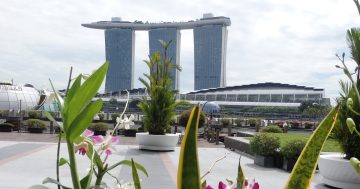By Christine Salins.
Hong Kong is one of the great food cities of the world, but beyond the twinkling harbour lights, swish rooftop bars and glamorous restaurants, there’s another Hong Kong, filled with the sights, smells and flavours that have been around forever and a day.
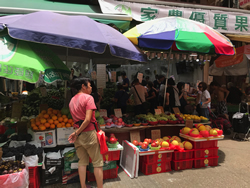 As a visitor, it’s not always easy to find these authentic local experiences – sometimes you don’t know where to look; other times they can be right under your nose but you don’t have the knowledge or the confidence to enjoy them.
As a visitor, it’s not always easy to find these authentic local experiences – sometimes you don’t know where to look; other times they can be right under your nose but you don’t have the knowledge or the confidence to enjoy them.
Doing a walking tour is always a great way of getting to know a city through the eyes of a local. Combine that with a food theme and I’m truly in my element – getting to know the food is getting to know the soul of a place.
Eating Adventures runs a number of food tours in Hong Kong, each of them focusing on a different section of this colourful and vibrant city. All of them are done on foot and all are led by local guides, not expats.
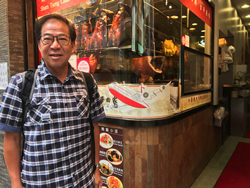 William, our guide on a tour of Hong Kong’s Mong Kok district, is a retired pharmacist who loves food and is a keen cook. He is like a walking encyclopedia when it comes to identifying all the fruit, vegetables, meat and seafood at the Mong Kok Wet Market.
William, our guide on a tour of Hong Kong’s Mong Kok district, is a retired pharmacist who loves food and is a keen cook. He is like a walking encyclopedia when it comes to identifying all the fruit, vegetables, meat and seafood at the Mong Kok Wet Market.
“Yam is good for soups and stir-fries,” he says, then holding up a pomelo leaf: “You put it in the bath if you are cursed with bad luck.” Stopping at a chicken shop, he provides further words of wisdom: “dark chicken is good for ladies after delivery”.
The Mong Kok market, which has existed in the same location for more than 100 years, is open every day and is staggering, both in the range of food on offer and in the quality – greens so vibrant they look like they have been picked just hours earlier, fruits and vegetables so enormous they could feed an army, seafood so fresh it is still wriggling in the tanks.
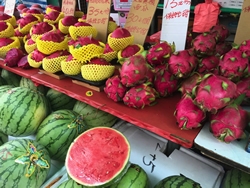 Also more than a century old is the tofu shop, where the employees start working at midnight to produce the next day’s batch. “It’s our daily staple,” says William as he hands us a plate of delicious bean curd pudding with palm sugar to taste.
Also more than a century old is the tofu shop, where the employees start working at midnight to produce the next day’s batch. “It’s our daily staple,” says William as he hands us a plate of delicious bean curd pudding with palm sugar to taste.
We seek out some local restaurants too, starting with a third-generation family business selling goose meat, one of Hong Kong’s signature dishes. William gives us the full rundown on how the whole process of preparing and roasting it with honey and seasonings takes about six to seven hours.
Only a handful of restaurants are still doing the snake soup that we enjoy with some very aromatic dried lemongrass sprinkled on top. But dim sum restaurants are thriving, as evidenced in the very crowded tearoom where we sample dumplings, stuffed chillies, and crispy rice rolls. “Dim sum houses are changing very fast,” says William, noting that they have kept pace with the times by introducing new sauces and creative twists.
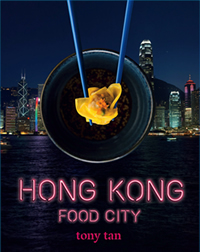
We visit a Michelin award winning bakery, sample egg tarts from a cake shop that has been operating for nearly 100 years, and drink sour plum tea (which ironically is quite sweet) in a traditional herbal tea shop.
The Eating Adventures tour offers little gems that we could never have discovered on our own. “Even if people follow a guide book, they don’t know the way to the snake shop,” says William. “We try to let our guests understand the local culture.”
Hong Kong Food Tour: www.eatingadventures.com/HONG-KONG-FOOD-TOURS.html
The following recipe comes from Tony Tan’s excellent cookbook/travelogue, Hong Kong Food City, published by Murdoch Books. Tan is a Malaysian-born Australian food writer who knows Hong Kong like the back of his hand.
 Steamed Pork and Prawn Dumplings
Steamed Pork and Prawn Dumplings
25 to 30 square wonton wrappers
2 tablespoons finely chopped carrot
Filling:
2 dried shiitake mushrooms, soaked in hot water until softened
300 g pork belly, coarsely chopped
180 g peeled uncooked prawns, coarsely chopped
80 g water chestnuts, chopped
2 tablespoons light soy sauce
1½ tablespoons Shaoxing rice wine
2 teaspoons sesame oil
2 tablespoons finely chopped ginger
1 spring onion, thinly sliced
1 egg white
2 tablespoons potato flour
To make the filling, squeeze the excess water from the mushrooms, discard the stems and finely chop the caps. Combine the mushrooms in a large bowl with
the remaining ingredients, season with salt and pepper and mix well. (Dim sum chefs tend to stir the mixture in one direction 20 times.) Cover the bowl with plastic wrap and set aside for 20 minutes to marinate.
Place a teaspoonful of filling in the centre of each wrapper. Bring up the
sides and gently squeeze to hold in the filling. Smooth the top of the filling with
a knife and gently tap the bottoms of the dumplings on the bench so they stand upright. Top each dumpling with a pinch of carrot.
Line a bamboo steamer with baking paper and make a few tiny slits to allow the steam to rise through. Or lightly brush the steamer with oil. Steam the dumplings in batches for 8–10 minutes or until cooked through. Serve at once.
From: Hong Kong Food City, by Tony Tan. Murdoch Books RRP $49.99. Photography by Greg Elms.


